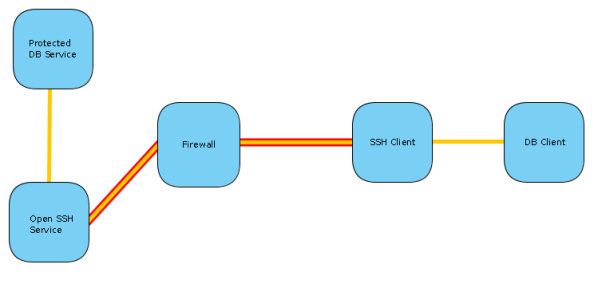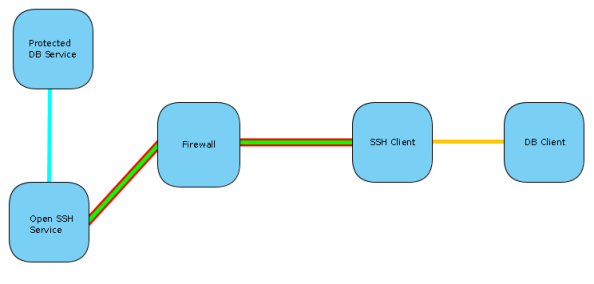Archive
Tunneling with SSH
Tunneling
Assume you have a database service, protected from any external traffic by a firewall. In order for you to connect to this service you need to first get past the firewall, and this is where the tunnel comes in. The firewall is configured to allow SSH traffic to another host inside the network, and it’s via the SSH service that the tunnel will be created.
So you would have an SSH client connect to the SSH server and establish a tunnel. Then any traffic from the database client will be intercepted and sent via the tunnel. Once it reaches the the host behind the firewall, the traffic will be transmitted to the database server and the connection will be established. Now any data sent/received will be traveling along the tunnel and the database server/client can communicate with one another as if there is no firewall.
This tunnel is very similar to an IPSec tunnel, except not as reliable. If you need a permanent tunnel to be used to protect production service traffic, I would rather use an IPSec tunnel for these. This is because failed connections between the tunnel ends are not automatically reestablished with SSH as it is with IPSec. IPSec is also supported by most firewall and router devices.
TCP Forwarding
TCP Forwarding is a form of, and very similar to tunneling. Except in the tunneling described above the DB client will establish a connection as if directly trying to connect to the database server, and the traffic will be routed via the tunnel. With TCP forwarding the connection will be established to the SSH client, which is listening on a configured port. Once this connection is established the traffic will be sent to the SSH server and a preconfigured connection established to the database from this side.
So where tunneling can use multiple ports and destination configured on a single tunnel, a separate TCP forwarding tunnel needs to be established for each host/port pair. This is because the whole connection is preconfigured. You have a static port on the client side listening for traffic. Any connection established with this port will be directed to a static host/port on the server side.
TCP forwarding is the easiest to setup and most supported method in third party clients of any of the SSH tunneling methods.
SOCKS Proxy
This is a very exciting and useful tunneling method in OpenSSH. It can be seen as dynamic TCP forwarding for any client supporting SOCKS proxies.
So what you would do is configure the SSH client to create a SOCKS proxy on a specified local port. Then your browser is configured to use this port as a SOCKS proxy. Any web sites you will be visiting will be tunneled via the SSH connection and appear to be coming from the server the SSH service is hosted on.
This allows you to get past filtering proxies. So if your network admin filters certain sites like Facebook, but you have SSH access to a network where such filtering doesn’t happen, you can connect to this unfiltered network via SSH and establish a SOCKS proxy. Using this tunnel you can freely browse the internet.
Why is this useful?
Since SSH traffic is encrypted, all of these methods can be used to protected against sniffers on the internet and in your local network. The only parts that are not encrypted would be between you and the SSH client (very often configured on your own PC) and the part between the SSH server and the destination (very often a LAN). So if you have software using a network protocol that doesn’t support encryption by itself, or which has a very weak authentication/encryption method, an encrypted tunnel can be used to protect it’s traffic.
Also, if you need to get past firewalls for certain services, and you already have SSH access to another host who is allowed past the firewall for these services, you can get the desired access by tunneling via the SSH host.
Depending on your tunnel configuration, you can hide your identify. This is especially true for SOCKS proxy and TCP forwarding tunnels (but also possible with standard tunnels). The source of the connection will always appear to be the server end establishing the tunneled connection.
Avoiding being shaped. SSH traffic is many times configured to be high priority/low latency traffic. By tunneling via SSH you basically benefit from this, because the party shaping the traffic cannot distinguish between tunneled SSH traffic and terminal SSH traffic.
There are many more use cases for this extremely powerful technology.
So Why Love Linux? Because it comes with OpenSSH installed by default.
Flexible Firewall
I have a very strict incoming filter firewall on my laptop, ignoring any incoming traffic except for port 113 (IDENT), which it rejects with a port-closed ICMP packet. This is to avoid delays when connecting to IRC servers.
Now, there is an online test at Gibson Research Corporation called ShieldsUP!, which tests to see if your computer is stealthed on the internet. What they mean with stealth is that it doesn’t respond to any traffic originating from an external host. A computer in “stealth” is obviously a good idea since bots, discovery scans or a stumbling attacker won’t be able to determine if a device is behind the IP address owned by your computer. Even if someone were to know for sure a computer is behind this IP address, being in stealth less information can be discovered about your computer. A single closed and open port is enough for NMAP to determine some frightening things.
So, since I reject port 113 traffic I’m not completely stealthed. I wasn’t really worried about this, though. But I read an interesting thing on the ShieldsUP! page about ZoneAlarm adaptively blocking port 113 depending on whether or not your computer has an existing relationship with the IP requesting the connection. This is clever, as it would ignore traffic to port 113 from an IP, unless you have previously established a connection with the same IP.
Being me, I found this very interesting and decided to implement this in my iptables configuration. The perfect module for this is obviously ipt_recent, which allows you to record the address of a packet in a list, and then run checks against that list with other packets passing through the firewall. I was able to do this by adding a single rule to my OUTPUT chain, and then modifying my existing REJECT rule for port 113. It was really that simple.
The 2 rules can be created as follows:
-A OUTPUT ! -o lo -m recent --name "relationship" --rdest --set
-A INPUT ! -i lo -p tcp -m state --state NEW -m tcp --dport 113 -m recent --name "relationship" --rcheck --seconds 60 -j REJECT --reject-with icmp-port-unreachable
The first rule will match any packet originating from your computer intended to leave the computer and record the destination address into a list named relationship. So all traffic leaving your computer will be captured in this list. The second rule will match any traffic coming into the computer for port 113 to be checked against this relationship list, and if the source IP is in this list and has been communicated with in the last 60 seconds, the packet will be rejected with the port-closed ICMP response. If these conditions aren’t satisfied, then the action will not be performed and the rest of the chain will be evaluated (which in my case results in the packet being ignored).
Note that these 2 rules alone won’t make your PC pass this “stealth test”. For steps on setting up a stealth firewall, see the Adaptive Stealth Firewall on Linux guide.
So Why Love Linux? Because built into the kernel is netfilter, an extremely powerful, secure and flexible firewall, and iptables allows you to easily bend it to your will.


